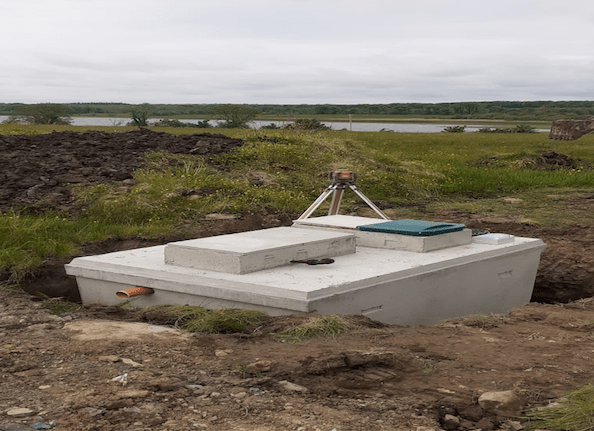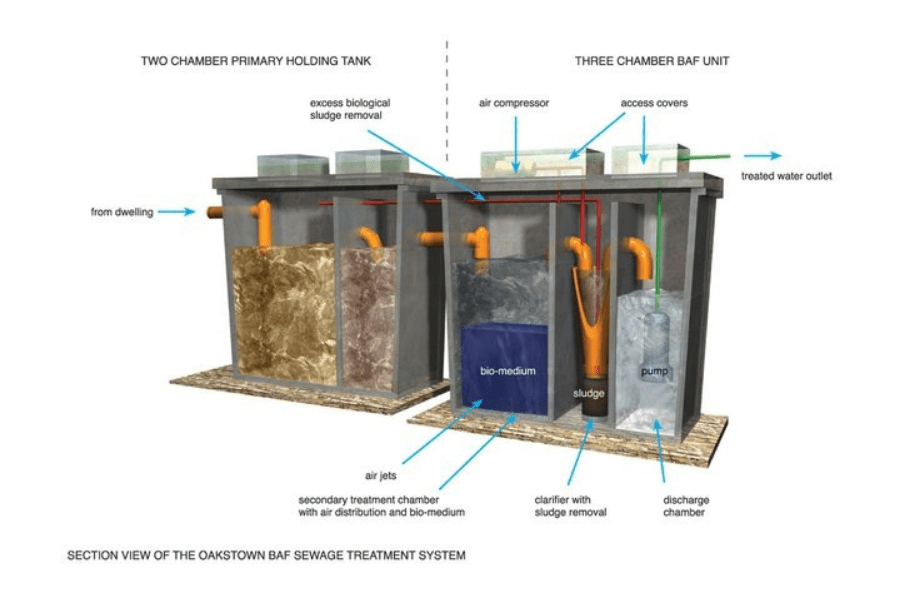FAQ’s
Whether you are building your new home or considering replacing/upgrading an existing septic tank this is one decision you will want to get right. The most common questions people ask are listed below in our FAQ’s section.
What happens to wastewater from my home?
When houses are not served by a public sewage system, the wastewater from a house should be treated by a septic tank and then the percolation area, or an advanced Oakstown BAF Sewage Treatment System and the percolation area.
With new houses the type of system used is determined by testing ground/soil conditions at planning stage.
Many older houses may not have systems that are up to current standards.

Oakstown BAF 6 PE Sewage Treatment System
How does a wastewater treatment system work?
A modern Oakstown BAF Sewage Treatment System contains five chambers followed by a percolation area.
Chambers one and two act as holding chambers which allows for Anaerobic digestion over an extended period of time before the effluent reaches the treatment chamber by gravity flow where it is further broken down by Aerobic digestion.
The effluent then passes through the settlement chamber where any remaining particles are removed before it reaches the final pump chamber where it is pumped out to the percolation area where the effluent is further purified through the soil or sand.

8PE BAF Sewage Treatment System
What is a wastewater treatment system?
Wastewater Treatment Systems (WWTS) consist of mechanical aeration or filtration units that enhance the treatment of domestic wastewater.
A percolation area or polishing filter is installed after these systems to allow further treatment of the wastewater.
These systems may be suitable in some areas where a septic tank system is not acceptable.
Is a septic tank and a wastewater treatment system the same thing?
No, septic tanks simply separate and partially treat waste by natural breakdown and typically discharge by gravity. Whereas a wastewater treatment system treats using aeration (adding oxygen to) the wastewater.
The extra oxygen accelerates the natural biological process of breaking down the waste in the sewage. Wastewater treatment systems are often incorrectly referred to as septic tanks. They are also commonly referred to as:
- Mechanical Aeration Systems
- Sewage / Sewerage Treatment Systems
- Biocyle / Biocyles
- BAF Systems
What is a percolation area?
A percolation area typically consists of a system of sub-surface perforated pipes which allow the liquid waste to be absorbed and filtered by the soil.
Flexible land drainage pipes are not permitted for percolation areas. Solid 100mm (4inch) pipes perforated typically at 4, 6 and 8 o’clock are recommended to provide even distribution of effluent in the percolation area.
A well designed and properly levelled distribution box is also critical for proper percolation.
What is a polishing filter?
Polishing filters consist of either soil or sand and are employed to reduce microorganisms from wastewater. They are used to treat wastewater from advanced treatment systems and constructed wetlands to allow for the discharge of treated wastewater to ground.
Polishing filters typically uses a smaller 32mm piping in a network which is pressurised and can be laid out in a smaller footprint due to it been pressurised instead of gravity fed.
How do I know if my wastewater treatment system is not working properly?
Some signs that your wastewater treatment system may not be working include the following:
- Smell of sewage from the general area of the tank and percolation area.
- Slow draining toilets, sinks or drains or backing up of sewage at the inlet.
- Overflow of wastewater from the tank or ponding of sewage on the percolation area.
- Discolouration of nearby watercourses (greyish slime growths)
What distance should my septic tank or wastewater treatment system be from my well?
The EPA (Environmental Protection Agency) Code of Practice 2021-table 6.2 sets out the required minimum distances to dwellings, boundaries, watercourses/streams, roads and wells.
O’Reilly Oakstown offer a free site survey where we will advise accordingly, contact us here to request one.
My house is over 20 years old – how do I know if my septic tank is working effectively?
In areas with poor soil percolation properties, soakpits, or direct discharges from soakpits, pose a risk to local surface waters. In areas with very shallow soil and high percolation rates soakpits, and in particular a cluster of soakpits, pose a risk to local ground waters.
The use of soakpits significantly increases the risk factor and households using soakpits should consider upgrading their systems. It is likely that the use of soakpits will be targeted in new legislation and in measures adopted to protect surface and ground waters.
When buying a house what do I need to do?
Before buying a house you should have the septic tank or wastewater treatment system inspected by a suitability qualified person.
Ensure to ask for installation and maintenance records for the system.
You should check that the treatment system will adequately serve the anticipated number of occupants of the house.
How do I care for my household wastewater treatment system?
You should visually check your system at least every six months and note any ponding of effluent, bad smells or discolouration of nearby drains.
If you have an advanced treatment system check the electrical components (pump, blower etc) are operational.
Don’t be tempted to turn off the power to save electricity – if there is no air going to the system it becomes an undersized septic tank and treatment is ineffective.
You should also check the distribution box i.e. the manhole between the wastewater treatment system and the percolation area to ensure even distribution of effluent and ensure there are no blockages.
Contact us here to find out about our Maintenance Services
How often do I need to desludge my septic tank or advanced wastewater treatment system?
The EPA (Environmental Protection Agency) recommend that a septic tank is desludged at least once a year but this varies with the system’s capacity and use.
Why do I need to desludge my household wastewater treatment system?
If the level of sludge builds up in the tank it may make its way out of the tank and block the distribution box and the percolation area or polishing filter. And if the percolation area or polishing filter becomes blocked it is very difficult to clean and may require replacement – an expensive option!
I have noticed ponding in my garden close to my wastewater treatment system - what should I do?
First of all you should arrange to have your system desludged. If it is an advanced wastewater treatment system you should contact the supplier of your system and have your system serviced.
Contact us here to find out about our Maintenance Services
Should “grey water” from dishwashers, sinks and washing machines be directed to my wastewater treatment system?
YES – grey water should in all circumstances be directed to the wastewater treatment system.
Grey water is also a pollutant and if directed to the rain water system may cause contamination of waters.
Take care with house extensions or alterations – don’t connect any wastewater pipes to the rainwater disposal system.
Can I upgrade my existing septic tank into a wastewater treatment system?
Yes, this is possible. Our experienced team can carry out a visual inspection of your current tank and recommend accordingly.
If you existing septic tank is precast concrete, watertight (tank and lids) and has a baffle wall in place there is every chance that this can be upgraded by adding the second tank of our 8 person BAF wastewater treatment system.
Contact us here to get a call back and discuss your needs
We hope these FAQ’s are of some help. If you have any other questions which are not answered here, please contact us and we will happily answer any other FAQ’s or further queries. You will also find some answers on our 6PE Sewage Treatment Tank Page. See also group website for O’Reilly Concrete




